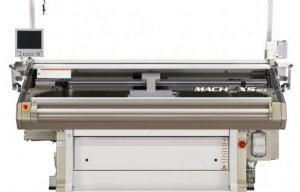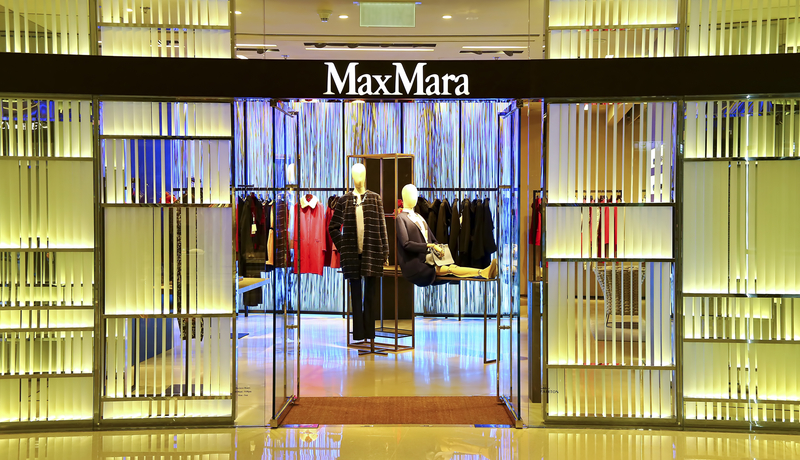
Shima Seiki Innovation Factory moves to Tokyo
This article, one of a WHOLEGARMENT series, sets out to investigate the impact of the technology on Italy’s knitwear industry and its leading advocates.

6th November 2015
Knitting Industry
|
Reggio Emilia
This year is the 20th anniversary of the launch of Shima Seiki’s WHOLEGARMENT knitting, a revolutionary flat knitting technology that allows the production of ‘seam-free’ knitwear. The technology was launched at ITMA in Milan in 1995 and this month the Japanese company will return to the city to celebrate at ITMA 2015. This article, one of a WHOLEGARMENT series, sets out to investigate the impact of the technology on Italy’s knitwear industry and its leading advocates.
Last month I visited Reggio Emilia, a city in northern Italy in the Emilia-Romagna region with a population of around 170,000 people. The economy of the province of Reggio Emilia was for a long time based on agriculture and one of its typical products, which became known worldwide, is Parmigiano-Reggiano cheese - another is Lambrusco wine.

In the twentieth century Reggio Emilia and its territory saw the rapid development of its light industry, particularly in mechanics for the agricultural sector. But it also became known as the home of a number of leading fashion houses, including the prestigious Max Mara clothing line which is headquartered in the city. And, appropriately it's IMAX, a Max Mara company that I’ve come to visit.
Max Mara is a luxury Italian fashion house belonging to the Max Mara Fashion Group. Founder, Achille Maramotti began designing couture clothing in 1947 and officially established Max Mara in 1951. The word ‘Mara’ comes from a shortening of his surname, while ‘Max’ is a superlative chosen to strengthen the brand's name and give it a more international feel.
Maramotti is said to have been one of the first people to envision that industrial processes could support the production of high quality designer clothing, during a time when fashion was seen solely as an artisanal activity. He was thus a forerunner of the current concept of ‘ready-to-wear’ clothing.
Over the years, designers for the Max Mara brand have included some iconic names like Karl Lagerfeld and Dolce & Gabbana. The company is still owned by the Maramotti family and currently has over 2000 stores in more than 90 countries.

Max Mara comprises of 37 different brands, many of which are strong in knitwear, and the Max Mara womenswear main line remains at the core of the company. Other labels include Sportmax, Sportmax Code, Weekend Max Mara, Marella, Pennyblack, iBlues and Marina Rinaldi, with the latter being named after Achille Maramotti's great grandmother, who in the 1800s owned a haute couture business in the heart of Reggio Emilia, their home town. Achille Maramotti died in 2005 and today his sons Luigi and Ignazio and his daughter Ludovica run the family business
IMAX, which belongs to Max Mara’s Knitwear Division, has the sole purpose of developing knitwear samples and knitting data for the Max Mara brands. The company has a full range of the latest Shima Seiki technologies, including the company’s four needlebed MACH2X WHOLEGARMENT technology and its SRY183LP machine for so called ‘knit-weave’ type fabrics - machines are available in every gauge from 3 to ultra-fine 18 gauge. Although IMAX physically looks and feels like a factory, it is very much a development and sampling unit.
Max Mara has its own production in Italy, including WHOLEGARMENT production, but it also has a number of companies producing on its behalf, which it does not own. IMAX develops knitwear for both types of producer.
IMAX makes samples, especially complex samples for all 37 Max Mara brands and each brand has four collections per year – two spring-summer and two autumn-winter. So this is a very busy unit, although there is an overall feeling of accuracy, organisation and calm. This feels more like a haute couture work room rather than a buzzy design studio. The emphasis here is on precision and fit.

IMAX has a small highly skilled team, which approaches sampling from a woven garment pattern making angle using Shima Seiki’s pattern making software. The team is headed by knit specialist Giancarlo Baroni and head of pattern making Ignazia Manfré. The whole development unit totals twenty four people, four of whom are highly skilled pattern cutters from different high-end backgrounds. Most of IMAX’ staff have worked for the company for many years.
This is a company that really knows how to exploit Shima Seiki technology to the full, having completely bought into and utilised the Shima Seiki Total Knitting System for the past 10 years. Max Mara, through IMAX, is in fact a world leader and expert in the Total Knitting System.
With Shima Seiki’s SDS-ONE APEX3 3D design system at its core, the Total Knitting System is designed to provide comprehensive support of the knit supply chain from product planning, yarn design, presentation and sampling to production and even sales promotion. Ultra-realistic simulation capability allows Virtual Sampling to minimize the costly time and resource consuming sample making process. Products can also be evaluated using 3D fitting simulation.

Traditionally, the knitted silhouette is produced with fashioning frequency or by drawing a shape using programming software with graphic interface. However, these methods take much experience and know-how because narrowing and widening require very fine adjustments. SDS-ONE APEX3's is said to provide the ideal solution with its patternmaking software, allowing the freedom to produce high-quality shaped items and WHOLEGARMENT knitwear with new and unique silhouettes.
Two of IMAX’ Shima Seiki programmers also use APEX3 for swatch simulation and garment simulation. The unit employs 7 programmers in total, one of which is a WHOLEGARMENT specialist.

During my visit I was shown printed garment simulations alongside actual knitted garments but as would be expected with a leading fashion house like Max Mara, photographing garments was not permitted. The sweaters from the current Max Mara collection in Cariaggi’s Jaipur cashmere/silk were exquisite and the simulations in multiple colourways were incredibly realistic. High quality Epson printers are used for large scale printing.
Over the years Max Mara has carried WHOLEGARMENT knitwear in its various collections and was an early adopter of the technology. I ask Giancarlo Baroni why the company has invested in WHOLEGARMENT technology. He explains: “We believe that WHOLEGARMENT adds extra value to the product. It gives you the opportunity to develop products with the best wearability, thanks to the technological evolution of these machines in recent years.”

Max Mara first invested in WHOLEGARMENT technology in 1999 with Shima Seiki’s SWG-V machines and significant numbers of WHOLEGARMENT sweaters are now made using the technology. ”At the moment around 10% of our overall production is WHOLEGARMENT, but it is showing a strong increase, thanks to the introduction of gauges 15 and 18, which are currently very popular in the fashion world,” Giancarlo Baroni says.
I ask Giancarlo what the benefits of the WHOLEGARMENT investment have been for Max Mara. “From a productive point of view, the benefits are a clear reduction of production time and of total ‘lead time’, especially as garment make-up operations on those products are either nonexistent or dramatically reduced,” he explains, adding: “Because we don’t need to worry about garment make-up costs, the cost of production with WHOLEGARMENT technology is very interesting and very competitive.”
I ask whether customers understand the benefits of WHOLEGARMENT technology and whether it is difficult to in fact communicate the benefits to them. Giancarlo explains that because IMAX’ customers are actually Max Mara Group brands, the company periodically organizes technical seminars with its sales network with the purpose of explaining the essential elements and features of its knitwear. In particular, the intention is to highlight the benefits of the company’s WHOLEGARMENT products and the unique features obtained by using the technology.

I ask whether the company had needed much in the way of support from Shima Seiki Italia when implementing WHOLEGARMENT technology. Giancarlo clarifies: “The support and updates provided by Shima Seiki Italia allow us to exploit as best we can the potential of latest technology and this is essential.”
“Regarding production, where we mostly use complex machines like the MACH2X, potential is often not exploited fully unless we make specific preparations. With regards to the designs made at IMAX, it is necessary to have continuous support from Shima Seiki Italia where we are provided with ongoing courses each year on all technical aspects and the latest innovations.”
I ask if the switch to WHOLEGARMENT knitting has gained the company new customers. “New customers for the different brands, yes of course,” Giancarlo emphasizes.
“The fascinating world of knitting contains aspects of research, technical aspects combined with style that deserve to be explored with the final consumer. You often stop only to look at the garments without thinking about how much work there is behind them,” he adds.
I enquire how Giancarlo sees the future of WHOLEGARMENT for Max Mara. “Considering the difficulty to find skilled labour for the garment make-up stage, we believe that it will continue to expand,” he concludes.
“If you could change anything in the way you adopted WHOLEGARMENT technology, would you do anything differently, I ask. “Absolutely not,” Giancarlo enthuses. “Our company believed in WHOLEGARMENT technology since its early development.”
WHOLEGARMENT is a ‘must have’ technology for Italian knitwear manufacturer Martignoni Paola
New Twins set to become leading player in theatre of WHOLEGARMENT knitwear
MIND Srl – A WHOLEGARMENT Success Story from Italy’s Veneto Region
WHOLEGARMENT investment cuts labour costs and creates new opportunities for Sabry Maglieria
La Trama: A WHOLEGARMENT Powerhouse in Italy’s Marche Region

Business intelligence for the fibre, textiles and apparel industries: technologies, innovations, markets, investments, trade policy, sourcing, strategy...
Find out more